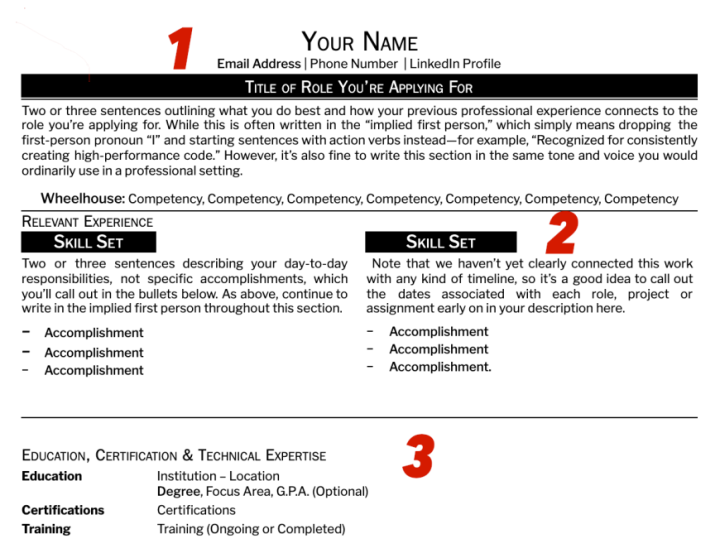The emergence of all-digital hiring processes. The increasing importance of ongoing learning and development. The extent to which work-from-home options have become a baseline expectation among candidates.
It’s obvious that the world of work is changing rapidly, but not everyone realizes how resume-writing best practices are changing with it.
What’s new? What isn’t? And what do you need to know in order to present your candidacy in the best way possible? In this article, we’ll delve into three of the highest-impact resume formats for 2024:
- Reverse-chronological resumes
- Functional resumes
- Combined resumes
In addition to guidance, recommendations and use cases, we’ve included downloadable templates for each resume format below—so go ahead and bookmark this page as your definitive resume playbook going forward. Plus, once you’ve got your own resume together, you should check out all of the job opportunities available at Johnson & Johnson.
1.
Overview
- Presents an easy-to-follow, linear career narrative, beginning with your most recent professional experience and working backward from there
- The most widely used resume format
Advantages
- Eliminates confusion and presents your professional experience in a clear, easy-to-understand format
- Usually creates an impression of career growth and progression
Drawbacks
- May call attention to gaps in your employment history
- Skills and competencies aren’t always clear
- Not the best format if you’re pursuing a new path in your career
Note that the numbers in the list below correspond to the numbers in the image above—and that you can download our reverse-chronological resume template if you want to start customizing your own.
- Start with your name and contact information (which should be pretty straightforward), type in the role you’re applying for and move on to the candidate statement—the part where you try to connect your experience, interests and areas of expertise to the role in question. Do you best to keep it succinct, aiming to hit all the key points in three sentences or less.
- Next, summarize—two or three sentences, max—your day-to-day responsibilities in the role, keeping the details at a fairly high level and saving specific accomplishments for the bullet points. Try to make the tone and voice consistent with your candidate statement.
- Finally, time to wrap it all up. This section is where you can provide a quick summary of relevant details related to education, certification, training and professional development.
2.
Overview
- Functional resumes zero-in on specific projects, experiences and outcomes, thereby placing the emphasis on your skills and competencies, rather than your overall career progression
Advantages
- Great option for candidates who work in project-based, freelance or consultative capacities
- Shows how you contribute value by connecting skills to outcomes
Drawbacks
- Doesn’t chronologically document your career trajectory—the overall timeline isn’t going to be immediately clear, for example
- May leave unanswered questions in the minds of some recruiters and hiring managers
The numbers in the list below correspond to the numbers in the image above, and you can download our functional resume template if this seems like the right format for you—and you’re ready to start customizing your own.
- As in the first example on this page, jotting down your name and contact information is the first piece of the puzzle. Next, write the name of the job you’re applying for, followed by a short candidate statement, which answers the vital “why” questions: Namely, why should you be called up for an interview? Why are you the right candidate for this job?
- This is where you can break down your most directly relevant work experience for the job at hand. Emphasize dollars-and-cents value, or quantitative benefits you’ve delivered in the past, as much as possible. You want your skills to stand out.
- Close with relevant information about certifications, education or training you have received. Keep it short and sweet.
3.
Overview
- Combined resumes bring together the narrowly focused, more curated approach of a functional resume with the holistic perspective of a reverse-chronological resume
Advantages
- Highlights key areas where you can make an impact without skipping over the broader story of your overall work experience
- Can be more concise than a reverse-chronological resume
Drawbacks
- Usually less concise than a strictly functional resume
- May not be immediately clear to hiring managers and recruiters what type of resume they’re dealing with, thereby creating confusion
The numbers in the list below correspond to the numbers in the image above. Be sure to download our combined resume template if you’re ready to start customizing your own.
- Note that this one looks a lot like a functional resume, but with one notable addition (see number three). As before, start with your name, the job you’re applying for and your candidate statement.
- Call out projects, skills and experiences that are relevant to the job you’re applying for, doing your best to quantify deliverables—for example, the budget, timeline for completion or number of stakeholders involved—wherever possible.
- Document your work history, adhering to the organizational principles of a reverse-chronological resume—that is, starting with your most recent work experience and working backward in time from there. Be sure to include dates. Keep this as succinct as possible.
- Finally, be sure to include information around certifications, education or training that you have received.



